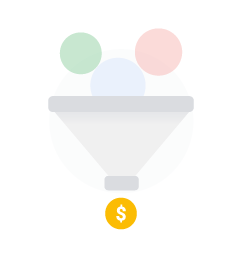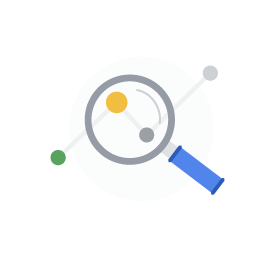If all advertisers can improve performance using AI-powered solutions, how can you differentiate and stand out from your competitors? Your knowledge of your customers and your business are key factors in guiding AI to success and improving your cross-channel bid strategy. It’s a virtuous cycle–you can multiply your results and marketing expertise with AI. At the same time, AI learns from you. Your secret sauce to augment results is providing it with six critical inputs. Click on each image to learn more:
 Add conversion values and use value-based bidding
Add conversion values and use value-based bidding
Drive better business results by advancing to a value-based bidding strategy that directly connects your marketing goals to real business outcomes
Having a robust conversion measurement strategy is one of the most important things you can do to help Google's AI maximize value for you. Setting conversion values is incredibly important to align your bid optimization with your broader business goals. While you can use bid strategies that focus on conversion volume such as Maximize conversions, you'll drive more value by moving to a value-based bid strategy like Maximize conversion value (with the option to add a target ROAS).
Defining the value of different conversions to your business helps Google's AI understand which conversions are most important and should be prioritized in bidding. This is especially important as you expand your marketing across channels in order to drive consistent conversion quality and value. If your business adds new types of conversions or the value of conversions change, make sure to update this to ensure that cross-channel bidding continues to seek the conversions that will drive real business outcomes. You can also use conversion value rules to easily adjust values for conversions based on geographic location, device and audiences in real time.
For example, a company that sells phone plans may value various types of leads differently based on their likelihood of resulting in a final sale. Filling in a lead form may be worth $20 to the company, while a phone call may be worth $50. An actual in-store visit could be worth $75. By indicating the relative importance of these different leads, Smart Bidding can prioritize the types of leads that bring you the most value for your budget across channels.
Did you know? If your business has offline conversions that aren’t captured by your online conversion tracking, using enhanced conversions, enhanced conversions for leads, or offline conversion imports allows you to optimize for even deeper conversions, including final purchases. This improves AI’s ability to find you the conversions that matter most to your business. When deciding on which method of offline conversion value sharing you want to use, you should consider the best fit for your marketing objectives.
Did you know? As greater emphasis is placed on privacy, users want greater control, resulting in many features that utilize third-party cookies being impacted. To build a privacy-safe digital advertising strategy, we recommend you use privacy-centric measurement solutions such as sitewide tagging, Google Analytics 4, enhanced conversions for web, and consent mode. By improving your measurement methods, you can build more accurate conversion models with machine learning and use new approaches that don’t track users across the internet. With a complete and more accurate picture of conversion performance, Smart Bidding will know where to invest across channels and drive better campaign performance.
 Provide audience signals
Provide audience signals
A major benefit of Google's AI is its ability to help you grow your business by unlocking new converting audience segments–even ones you might not have expected or known about before. Historically, advertisers have often limited their audience targeting to only reach a predefined set of “ideal” audiences in order to maximize ROI. But with the help of AI, you don’t have to choose between reach and ROI.
Using Google's AI, you can cast a wider net to find more valuable converting customers while maintaining relevance and ROI. You can also help shorten the “learning period” and accelerate AI's ability to drive results by sharing the unique insights you have about your customers. Google’s best practice recommendation is to provide your data about previous purchasers, and use custom segments to provide insight into the search keywords, web URLs, and apps your customers typically engage with. Your knowledge of your customers and why they’re valuable is vital to helping guide AI in the right direction.
In Performance Max campaigns, this information can be shared using audience signals. These audience suggestions are especially important to add during campaign set up or early in the campaign’s lifecycle to help your campaign ramp up faster. Audience signals continue to inform the campaign throughout its lifecycle, especially as first-party data is updated, so make sure to update your customer lists regularly.
Did you know? Check the Insights page to gain valuable information about your Performance Max campaign’s converting audiences that you can use in future marketing strategies. Audience insights show you which segments your conversions are coming from, which can give you ideas for new products to prioritize, asset types to test, and audiences to target in other marketing campaigns. Top-performing audience segments are surfaced and may be labeled as “Signal” or “Optimized”. “Signal” segments refer to audience signals that you inputted into Performance Max yourself. Meanwhile, “Optimized” segments are ones that you did not add yourself, but that AI helped find for you to unlock additional conversions. This knowledge helps you identify what audiences are performing well and discover new audiences you hadn’t considered or added.
 Consolidate your campaign structure
Consolidate your campaign structure
Google's AI works on your behalf to accurately predict which auctions are most likely to convert and are most valuable for your business. That’s why it’s best to avoid over-segmentation and to consolidate your campaign structure as much as possible to give AI full visibility and as much data as possible to maximize business value. With Performance Max campaigns, for example, we recommend building multiple asset groups within one campaign vs. creating multiple campaigns that only contain one asset group each (if the asset groups have similar bidding, location, and language targets).
By keeping traffic together, Google's AI can optimize marginal ROI across all traffic, helping to improve performance. The more you split up traffic, the more you restrict Smart Bidding from finding the most conversions at your target. Each campaign will try to reach the target separately, resulting in a higher marginal cost-per-conversion and a decrease in efficiency.
Note
You may need to create separate campaigns for bidding, budget or location targeting reasons. Or you may require separate ad or asset groups for different product or service categories. But overall, we strongly recommend consolidating your campaign structure. This makes campaign management easier and more importantly, it improves the results you get from Google's AI.
 Provide a range of high-quality creative assets
Provide a range of high-quality creative assets
Nowadays, just having simple text ads isn’t enough. Your customers are looking at images, videos, and more. In Performance Max campaigns, you’ll want to upload as many relevant, high-quality variations of text, image, and video assets as possible. The more assets you provide, the more ad formats the campaign can create and the more inventory your ad can appear on. Google's AI will mix and match a variety of assets to find the best-performing combination for each customer. This allows you to show your customers personalized and meaningful ads that are more likely to convert for your business.
You can look at ad strength and asset performance ratings to determine the quality of your assets, and identify new opportunities to improve. However, you shouldn’t remove any assets unless you’ve reached your maximum upload limits, since any underperforming ones will not serve as often anyways. Even assets with “good” or “low” ad strength may still perform well in some auctions and contexts.
For more in-depth tips, check out our creative best practices.
Did you know? We recommend uploading a video asset that is at least 10 seconds long. If you don’t have a video asset, Performance Max will use prebuilt templates and automatically generate a video for you based on your other assets to make sure you’re not missing out on valuable conversions from video inventory. You can also easily create your own video using the video creation tool in the asset library.
 Switch to data-driven attribution
Switch to data-driven attribution
Make better bidding decisions across channels by switching to data-driven attribution. Typically, all conversion credit goes to the last ad that customers interacted with. With data-driven attribution, cross-channel bidding can more accurately optimize for the touchpoints and channels that are most influential and incremental to driving conversions.
Make better bidding decisions across channels by switching to data-driven attribution and assigning conversion credit to multiple touchpoints that are the most incremental to driving conversions.
 Share more advanced inputs
Share more advanced inputs
There’s a variety of ways to add advanced inputs and grow your cross-channel bid strategy even further.
New Customer Acquisition
It’s important to view your campaigns through a goal-based lens, so that you can focus on your higher-level business goals, rather than just the specific channels that your ads appear on. If you’re focused on acquiring new customers, you can set up a new customer acquisition goal in your Performance Max campaign. The new customer acquisition goal allows you to value and then bid for new customers over existing customers (New Customer Value mode) or focus on new customers only while maximizing conversions (New Customer Only mode).
Customer acquisition value is the additional value adjustment to be added to a new customer’s first purchase conversion. Our recommendation is to set Customer acquisition value such that the Customer acquisition value plus the new customer's typical first purchase value represents the revenue that a typical new customer would bring over their lifetime. When you choose a value-based bid strategy, you can use this total value as the basis to set your ROAS targets.
By combining value-based bidding with New Customer Value mode, the bid strategy can bid more aggressively towards new customers compared to returning customers for the same purchase conversion value. The bidding algorithm will start to learn that new customers drive more value to the business and will start to optimize towards driving new customers as a result.
You have flexible ways to identify new customers, such as by providing your own first-party data through Customer Match lists, setting up conversion tags, or using Google’s auto-detection method. Using your first-party data drives the highest accuracy for new customer targeting and also helps prepare you for the deprecation of third-party cookies.
Did you know? New Customer Value mode can only be used alongside value-based bidding strategies to maximize conversion value, while New Customer Only mode can be used with both conversion value and conversion volume-based bid strategies.
Note
New Customer Value mode is the recommended mode because it lets you maximize revenue across all consumers while also driving more new customers to your business from a single campaign. We recommend New Customer Only mode only if you have dedicated acquisition-focused budgets, or if your campaign is focused on non-purchase goals like lead generation.
Profit data and customer lifetime value
Examples of other advanced inputs you can add by uploading your data include profit data or customer lifetime value. Two ways to bring profit data into Google Ads are to use a conversion tag with profit as the conversion value, or to use offline conversion imports with profit as a conversion value. You can make this data actionable via custom columns to integrate it into your bid strategy. You can also use conversion value rules to reflect your profit goals based on different dimensions like audience or geographic location.